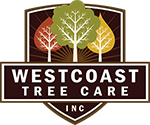Anacortes Tree Care
Many Anacortes, Washington homeowners wonder if the trees on their property are healthy or suffering from a disease or insect infestation. While you can look at your tree and try to interpret signs and signals, you won’t fully know if what you are seeing is a sign of concern. If you find yourself worrying about your trees, Westcoast Tree Care can help. Below are some of the most common warning signs that may indicate a sick or dying tree.
Leaf Spots & Holes
Leaf spots and holes are often a good indication of disease. When it comes to spots, it’s important to keep in mind that they can vary in size and shape. Keep in mind that the majority of leaf spots are often caused by fungal infections. However, there are certain bacterial diseases that can cause leaf spots as well. Furthermore, signs of an insect infestation include damage that results in leaf holes. If a tree on your property has leaf spots or holes, it’s most likely suffering from an insect infestation or fungus.
Cankers
Dead sections of bark can be a sign of tree cankers. Cankers can occur on the trunk of a tree or its branches. As a sign of injury, fungal infection, or bacterial infection, cankers can cause extreme damage or even kill a tree altogether if left untreated.
Canopy Dieback
Canopy dieback is a term used for the decline of a tree’s canopy. If a tree on your property isn’t looking as sparse or full as it has in the past, this could indicate a decline in its overall health. Canopy dieback can be a result of insect infestation, disease, old age, environmental stressors, and soil compaction. Furthermore, if the dieback of a canopy is isolated to certain areas of a tree, it could be a sign of extremely harmful and invasive pests like the Emerald Ash Borer.
Early Leaf Drop
If the leaves on a tree drop before they should in the fall, this is referred to as early leaf drop. Early leaf drop often indicates serious root and soil disorders as well as vascular diseases and boring insects such as the Emerald Ash Borer mentioned above.
Yellow & Brown Leaves
Yellow and brown leaves are a good indication that your tree is in trouble. Many Anacortes homeowners don’t get up close enough to their trees to notice other signs but yellow and brown leaves can really stand out against a healthy green color. Furthermore, yellow or brown leaves can be a sign that your tree is nutrient deficient or suffering from drought and heat stress.
Cavities
Cavities, holes, and hollows can develop in a tree for many reasons. These include stress, injury, over-mulching or buried root collars. These causes can lead to vascular collapse within a tree and decay pockets in the trunk wood. While cavities used to be treated by filling them in, it is not recommended now as it can ruin the structural integrity of a tree. While there is no treatment for cavities, they should, however, be inspected by a certified arborist to ensure a tree is safe or whether it needs to be removed.
Fungi
Mushrooms found throughout your yard aren’t typically a cause for concern. Fungi and mushrooms found at the base of the tree, however, can indicate a serious problem. As a common sign for interior decay or root rot, mushrooms and fungi can cause a tree to fall over unexpectedly or uproot easily during extreme weather. This, in turn, makes them an extreme safety hazard that needs to be removed by a certified arborist as soon as possible.
Westcoast Tree Care
These are some of the most common signs that your tree is sick, dying, or dealing with an insect infestation. If the trees on your property are showing any of these signs, contact Westcoast Tree Care by filling out our online form or call us at 1.800.767.8733 for an Anacortes tree care inspection. We will take the time to walk your property with you, answer any questions you may have, and provide you with a no-cost, no-obligation quote for any of our tree care services.








